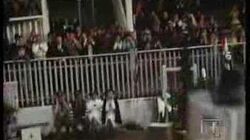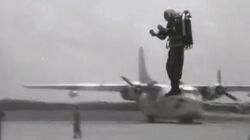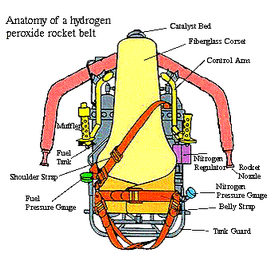
Bell Aerospace Rocket Belt
Short video on the history of the Bell Aerosystems rocket pack. For more info see wiki:

Bell Rocket Belt Flying Demonstrations, 1961 US Army; JQ Music
The Bell Rocket Belt is flown in several demonstrations during the Summer of 1961 in this compilation of footage. Venues include Fort Eustis Virginia, and the Pentagon courtyard.
The Idea[]
It was created as a possible civil and military transport, because it was intended to be used as a means of transportation on the moon during the Apollo missions as well as a army transport over things like ravines; however the Army decided not to use them because it was to costly and inefficient, but NASA turned it in to the NASA Astronauts' jet pack.
Development[]
Rocket belts stated in 1920s pulp science-fiction since, when Buck Rogers used a rocket belt.
Nazi Germany tried to make one during World War II by trying to strap two primitive pulse jet engines (one on front and one on back) to a dummy to see if a man could be made to fly with it.
Work started under engineer-missileman Wendell F. Moore at Bell Aerosystems 1953 experiments began in the mid-1950s.
In 1959 the U.S. Army contracted Aerojet General to conduct feasibility studies on thr Bell Rocket Belt and contracted Bell Aerosystems to develop a Small Rocket Lift Device (SRLD).
The device[]
Bell Textron Rocket Belt[]
Pilot Harold Graham tested it on on 3 May 1961.
On 11 October 1961, (according to other data, 12 October) the pack was demonstrated personally to President John F. Kennedy in the course of experimental maneuvers on the military base Fort Bragg. Graham took off from an amphibious Landing Ship, Tank (LST), flew over a strip of water, and landed in front of the President.
Sean Conery's James Bond flew it in a 1965 James Bond film Thunderball. US TV show Lost in Space.
It was flown by Bill Suitor and at the opening ceremony of the Los Angeles Olympic Games in 1984.
Moor 1969 Jet Pack[]
In 1969 Wendell Moore and John K. Hulbert of Bell Aerosystems had Williams Research Corporation design a turbojet small enough to be carried on a man's back. The new jet pack had a parachute system built into it but it wasn't very useful if the machine failed below a height of about 70 feet.
Wendell Moore died of complications from a heart attack in May of 1969. The project was shelved and the single jet pack sold to Williams Research Corporation where it now sits in the company museum.
The RB2000 Rocket Belt[]
In 1992 a company was formed by Brad Barker (a former insurance salesman), Joe Wright (a Houston-based businessman), and Larry Stanley (an engineer and owner of an oil well), after inviting professional inventor Doug Malewicki, with the goal and the t developing a new version of the rocket pack. It was a technical faliuer, with 1997 test flights only lasting 30 seconds per fuel tank, so they gave up and quit in 2002. Litigation and arguments over the ownership of the last belt had torn them apart since 1997. One of the team was later murdered by a unknown assent and the last belt was lost both in the 2000s.
The "Basic US GI factor"[]
It was assumed by the US Army that a 19 year old recruit with only basic training must be able to use the kit after a brief chat and couple of demonstrations without killing or seriously injuring himself or others. It was considered too skillful for a basic GI to use after such a low level of add-hock, in-field on the spot training as they envisaged.
Demonstration flights[]
It was demonstrated in Canada, Mexico, Argentina, Germany, and France, amongst other places during the 1960s. A artical on it was in the US Popular Science this time.
Stats[]

Diagram of the Bell Rocket Belt.
For use in the pack they selected a rocket engine with a thrust of 280 pounds-force (1.25 kN or 127 kgf). The pack with its fuel weighed 125 lb (57 kg). The pack had a solid glass-plastic frame contoured to the shape of the human body. The cylinders of fuel and nitrogen were attached to the frame.
The maximum duration of flight of the rocket pack was 21 seconds (30 seconds in the later variant) with a range of only 120m (135m in the later variant) and 5 U.S. gallons (19 liters) of scarce hydrogen peroxide was expended each time it was used.
The project cost US$150,000 (at 1961 rates) and then another US$50,000 (at 1962 rates), or about US$1,750,000 at 2015 rates. It reserved USA patent No 3243144, 1966 rocket pack "Bell Rocket Belt" in 1966.
| Technical characteristics of rocket pack | ||
|---|---|---|
| Bell Rocket Belt | RB 2000 Rocket Belt | |
| Duration | 21 s | 30 s |
| Thrust | 136 kgf (1.33 kN) (calculated 127 kgf or 1.25 kN) |
145 kgf (1.42 kN) |
| Maximum distance | approximately 250 meters or 820 feet | |
| Maximum altitude | 18 m (~59 feet) | 30 m (~98 feet) |
| Maximum speed | 55 km/h or 34 mph | 96 km/h or 60 mph |
| Equipped mass | 57 kg or 125 lbs | 60 kg or 132 lbs |
| Fuel stock | 19 liters or 5 gallons | 23 liters or 6 gallons |
- Crew: 1
- Length: 3 ft (0.91 m)
- Gross weight: 125 lb (57 kg) (less crew)
- Maximum speed: 52 kn; 97 km/h (60 mph)
- Endurance: 20 - 30 seconds
Also see[]
- North American X-15
- Bell Rocket Belt
- Avro Flying Car
- Bell Jet Belt
- Bell Helly Vector
- Bell Pogo
- KGB Chita Jet Belt
- Small Rocket Lift Device (SRLD)
- Space Race
- Bell Helli-jeep
- Lockheed X-17
- Bell X-1
- North American X-15
- Hiller Flying Platform
Links[]
- http://www.tecaeromex.com/ingles/RB-i.htm
- http://rocketbelts.americanrocketman.com/history.html
- http://www.unmuseum.org/notescurator/rocketbelt.htm
- https://en.wikipedia.org/wiki/Jet_pack
- http://rocketbelts.americanrocketman.com/history.html
- http://rocketbelt.nl/site.html
- http://www.smithsonianmag.com/smithsonian-institution/ill-fated-history-jetpack-180955294/?no-ist
- http://airandspace.si.edu/collections/artifact.cfm?object=nasm_A19730264000
- http://www.popularmechanics.com/flight/how-to/a1756/4217989/
- https://en.wikipedia.org/wiki/Jet_pack
- https://en.wikipedia.org/wiki/Bell_Rocket_Belt